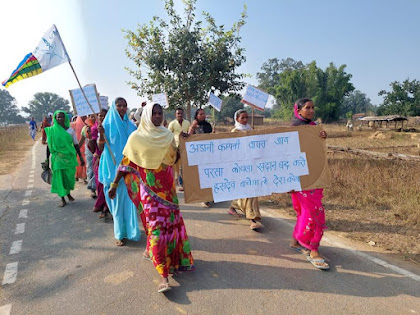SAVE HASDEO FOREST
Save Hasdeo forest
Nature conservation is the moral philosophy and conservation movement
focused on protecting species from extinction, maintaining and restoring
habitats, enhancing ecosystem services, and protecting biological diversity. A
range of values underlie conservation, which can be guided by biocentrism,
anthropocentrism, ecocentrism, and sentientism, environmental ideologies that
inform ecocultural practices and identities.[2] There has recently been a
movement towards evidence-based conservation which calls for greater use of
scientific evidence to improve the effectiveness of conservation efforts. As of
2018 15% of land and 7.3% of the oceans were protected. Many environmentalists
set a target of protecting 30% of land and marine territory by 2030
Introduction
Conservation goals include conserving habitat, preventing deforestation,
halting species extinction, reducing overfishing, and mitigating climate
change. Different philosophical outlooks guide conservationists towards these
different goals.
The principal value underlying many expressions of the conservation ethic
is that thenatural world has intrinsic and intangible worth along with
utilitarian value – a view carried forward by parts of the scientific
conservation movement and some of the older Romantic schools of the ecology
movement. Philosophers have attached intrinsic value to different aspects of
nature, whether this is individual organisms (biocentrism) or ecological wholes
such as species or ecosystems.
More utilitarian schools of conservation have an anthropocentric outlook
and seek a proper valuation of local and global impacts of human activity upon
nature in their effect upon human wellbeing, now and to posterity. How such
values are assessed and exchanged among peopledetermines the social, political
and personal restraints and imperatives by which conservation is practiced.
This is a view common in the modern environmental movement. There is increasing
interest in extending the responsibility for human wellbeing to include the
welfare of sentient animals.
Save Hasdeo forest
It is situated between North Korba, South Surguja and
Surajpur districts of Chhattisgarh. Spread over 170,000 hectares, this forest is
known for its biodiversity. According to the 2021 report of Wildlife Institute
of India, Hasdeo
Aranya is home to 10,000 people belonging to tribal castes like Gond, Lohar and
Oraon.
Adivasi men look
out on the vast PEKB coal mine that’s destroyed much of their ancestral land,
Hasdeo Forest in Chhattisgarh.
India’s Adivasi (Indigenous) communities are
resisting a plan to destroy vast areas of their forests for coal mines. They’re
up against huge corporations and the most powerful people in the country, and
they desperately need outside support.
The Prime Minister, Narendra Modi, wants a massive
expansion of coal mining in India, to one billion tonnes per year. 80% of the
new mining areas are on Adivasi lands.
Despite a decade of resistance from Adivasis,
Modi’s government has approved a massive new coal mine in the rich Hasdeo
Forest in Chhattisgarh state.
Over 20,000 Adivasi people live in, depend upon and
revere the forest. Their lands and livelihoods will be wrecked, and the mine
will be a disaster for the fight against the climate crisis.
Please email Narendra Modi and ask him to stop
mining in Hasdeo Forest and ensure no mining occurs on Adivasi lands without
their genuine consent. There’s not a moment to lose.
The environmental impact
As of May 2022, two studies by
the ICFRE and Wildlife Institute of India (WII) have come out. Both have
underlined the importance of biodiversity in the region that mining will
undoubtedly affect. They also address the issue of human-elephant conflicts,
noting that while Chhattisgarh has less elephants compared to other states, it
accounts for a significant percentage of conflict due to habitat loss or
clearing of forests. Further deforestation could lead to elephant movements
spilling over to urban areas, these studies have noted.
The ICFRE also noted the loss of
the natural environment and the “serious impact on the community in form of
loss of livelihood, identity, and culture” with regards to tribal people living
in the area, if mining were to be allowed. But it backed considering mining in
four blocks: Tara, Parsa, PEKB and Kente Extension with “strict environmental
safeguards”. It further said that the PEKB block was a “habitat to rare,
endangered and threatened flora and fauna”.
The protests
Some organisations, as well as individuals, have actively
campaigned against the mining in the area over the last decade. In October
2021, a 300-km-long march was undertaken by around 350 people from tribal
communities to Raipur alleging
“illegal” land acquisition.
On May 24, RRVUNL CMD told ANI
after meeting officials in Chhattisgarh: “Rajasthan will plunge into a severe
power crisis if it fails to get coal from Chhattisgarh”.
He claimed
that activists were “misguiding” local people, and that more than 8 lakh trees
had been planted in Chhattisgarh against those felled for mining On May
25, a press conference was held in Delhi ‘by Friends of Hasdeo Arand’ who alleged that fake gram
sabhas were constituted to indicate “consent” by the tribal people for mining
activities. They said that Hasdeo Arand’s issue was not merely local, but
linked larger issues of jal, jungle, zameen (water, forest, and land rights) of
the marginalised groups.
BY - SHUBHAM JAISWAL








good work
ReplyDeleteGreat work , great imformation
ReplyDeleteGood work
ReplyDeleteGreat initiative taken up and very informative 💯🙌
ReplyDeleteMaja aa gaya bhai or content lao
ReplyDelete